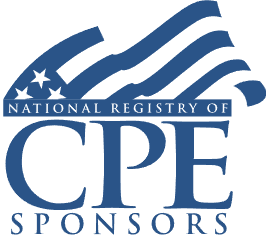Navigating IRS Scrutiny of R&D Tax Credits: Qualified Research Activity, Expenses, Research Credit Claims Audits

Course Details
- smart_display Format
Live Online with Live Q&A
- signal_cellular_alt Difficulty Level
Intermediate
- work Practice Area
Tax Law
- event Date
Tuesday, May 20, 2025
- schedule Time
1:00 p.m. ET./10:00 a.m. PT
- timer Program Length
90 minutes
-
This 90-minute webinar is eligible in most states for 1.5 CLE credits.
-
BARBRI is a NASBA CPE sponsor and this 110-minute webinar is accredited for 2.0 CPE credits.
-
BARBRI is an IRS-approved continuing education provider offering certified courses for Enrolled Agents (EA) and Tax Return Preparers (RTRP).
This CLE/CPE webinar will guide tax professionals and advisers on navigating IRS scrutiny and challenges to the R&D tax credit for small and large businesses and international taxpayers. The panel will discuss the recent IRS crackdown on documentation of research credit claims, managing IRS audits, qualified research activities (QRAs) and qualified research expenses (QREs), safe harbor for certain taxpayers, and techniques to assist in documenting and claiming R&D credits.
Faculty

Mr. Perez has extensive experience in the representation of clients in civil and criminal tax litigation and in tax disputes and controversies before the Internal Revenue Service and all the California taxing agencies. He was formerly a senior trial attorney with District Counsel, Internal Revenue Service, in Los Angeles, California. Mr. Perez is a Certified Tax Specialist, California State Bar Board of Certification and is also a Fellow of the American College of Tax Counsel. He frequently lectures on advanced civil and criminal tax topics at seminars and before national, state and local bar associations and accountancy groups. He is a co-author of the BNA Portfolio, Tax Crimes, has served as the Chair of the Los Angeles Lawyer Magazine Editorial Board and is the first recipient of the Los Angeles Lawyer Sam Lipsman Service Award for outstanding service to the Los Angeles Lawyer Magazine. He is past Chair of the Tax Procedure and Litigation Committees of the Taxation Sections of the State Bar of California and the Los Angeles County Bar Association. Mr. Perez is past President of the Alumni Board for the UCLA School of Law and has served as an Adjunct Professor, Golden Gate University, Graduate School of Taxation.

Mr. Stigile specializes in tax controversies as well as tax, business, and international tax. His representation includes Federal and state tax controversy matters and tax litigation, including sensitive tax-related examinations and investigations for individuals, business enterprises, partnerships, limited liability companies, and corporations. His practice also includes complex civil tax examinations, administrative appeals and tax collection proceedings (where he is widely respected for achieving meaningful resolutions of difficult tax collection issues). Mr. Stigile frequently writes and lectures on topics involving taxation.

Ms. Brown’s practice focuses on individuals and organizations who are involved in criminal tax investigations, including related grand jury matters, court litigation and appeals, as well as representing and advising taxpayers involved in complex and sophisticated civil tax controversies, including representing and advising taxpayers in sensitive-issue audits and administrative appeals, as well as civil litigation in federal, state and tax court.
Description
For many businesses, the R&D tax credit is one of the most significant tax benefits. When claiming the R&D credit, determining what constitutes a QRA and calculating QREs can be challenging.
The IRS has strict standards in examining R&D tax credit claims and has announced changes in documentation requirements for claims made concerning the credit for increasing research activities. In addition, the IRS recently issued procedural guidance now requiring taxpayers to submit specific pieces of information with any amended returns or administrative adjustment requests that claim an R&D credit.
Generally, Sec. 41 allows a credit for a percentage of a QRE that a taxpayer incurs engaging in research activities. The Code provides a four-part test to determine whether an activity can be considered a QRA. Expenditures, including wage expenses with sufficient nexus to the QRA, can be included in calculating the expenditure base. However, substantiating that an activity qualifies as a QRA can still be complex, and tax professionals must know the standards and limits in utilizing this important and overlooked credit.
Listen as our experienced panel discusses the recent IRS crackdown on documentation of research credit claims, managing IRS audits, QRAs and QREs, safe harbor for certain taxpayers, and techniques to assist in documenting and claiming R&D credits.
Outline
- Recent IRS guidance for the R&D tax credit
- Determining QRAs
- IRS regulations on QRA calculations
- Sampling and allocation methods for QREs
- Documentation and substantiation of credit claim
- Applying for credits against AMT or payroll tax liability
Benefits
The panel will discuss these and other important topics:
- Recent IRS guidance for claiming the R&D tax credit
- The four-part test to determine whether an activity can be considered a QRA for purposes of claiming a Section 41 R&D credit
- Documentation and substantiation requirements
- Sampling strategies for including wage QREs and other indirect costs in the credit calculation
- Best practices for businesses claiming a Section 41 R&D credit
NASBA Details
Learning Objectives
After completing this course, you will be able to:
- Recognize the tests for determining whether an activity qualifies as a QRA for purposes of claiming a Section 41 R&D credit
- Identify wage QREs and other indirect expenditures under Section 41
- Discern strategies when eligible small companies may use IRC 41 credits to offset payroll tax or AMT liabilities
- Verify that all R&D tax benefits available are utilized for the client's benefit

Strafford Publications, Inc. is registered with the National Association of State Boards of Accountancy (NASBA) as a sponsor of continuing professional education on the National Registry of CPE Sponsors. State boards of Accountancy have final authority on the acceptance of individual courses for CPE Credits. Complaints regarding registered sponsons may be submitted to NASBA through its website: www.nasbaregistry.org.

Strafford is an IRS-approved continuing education provider offering certified courses for Enrolled Agents (EA) and Tax Return Preparers (RTRP).
Related Courses

Purchase Price Allocations in M&A: Key Tax Considerations, Reporting Requirements, Pitfalls to Avoid
Saturday, March 22, 2025
1:00 p.m. ET./10:00 a.m. PT

Puerto Rico Act 60 Tax Exemptions: IRS Examination and Audits, Key Issues for Individual and Business Taxpayers
Monday, March 31, 2025
1:00 p.m. ET./10:00 a.m. PT

Federal and State Tax Residency Issues: Navigating IRS Examination Guidance, State Regulations, Remote Workers
Saturday, March 22, 2025
1:00 p.m. ET./10:00 a.m. PT

Taxation of Non-U.S. Investment in U.S. Private Credit Funds: Fund Structures, Tax Rules, Exceptions, Safe Harbors
Thursday, March 20, 2025
1:00 PM E.T.
Recommended Resources
How CPE Can Bridge the Gap Between What You Know and What You Need to Know
- Career Advancement
Gain a Competitive Edge Through Efficient CPE Strategies
- Learning & Development
- Business & Professional Skills
- Career Advancement